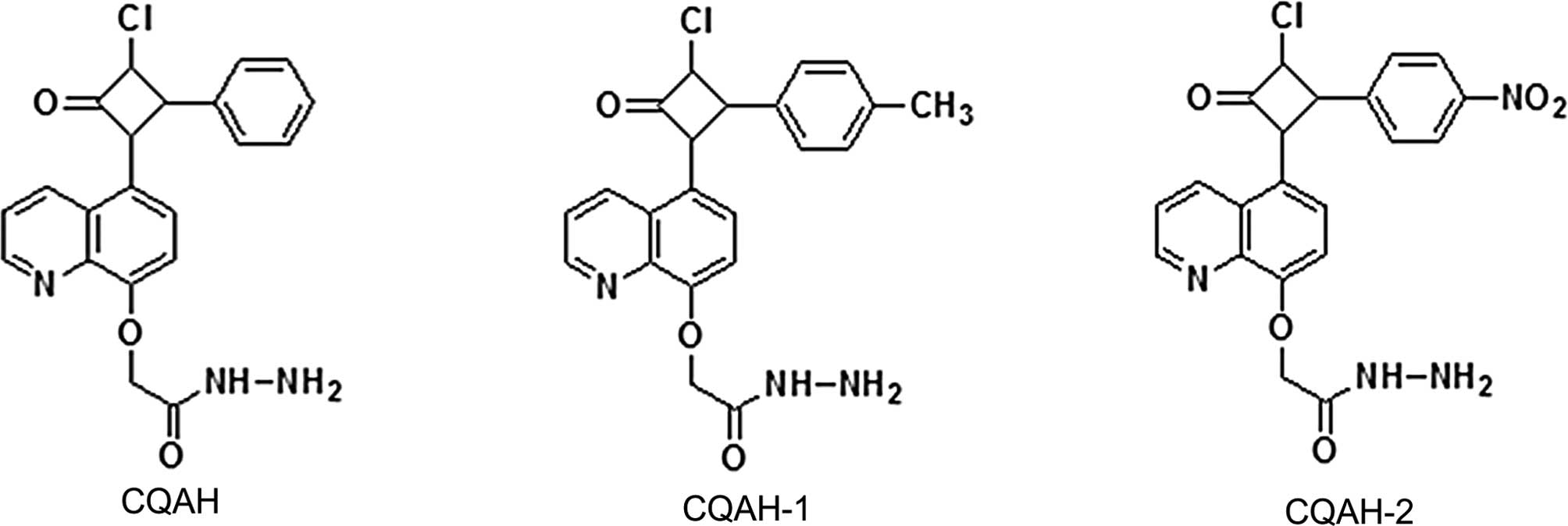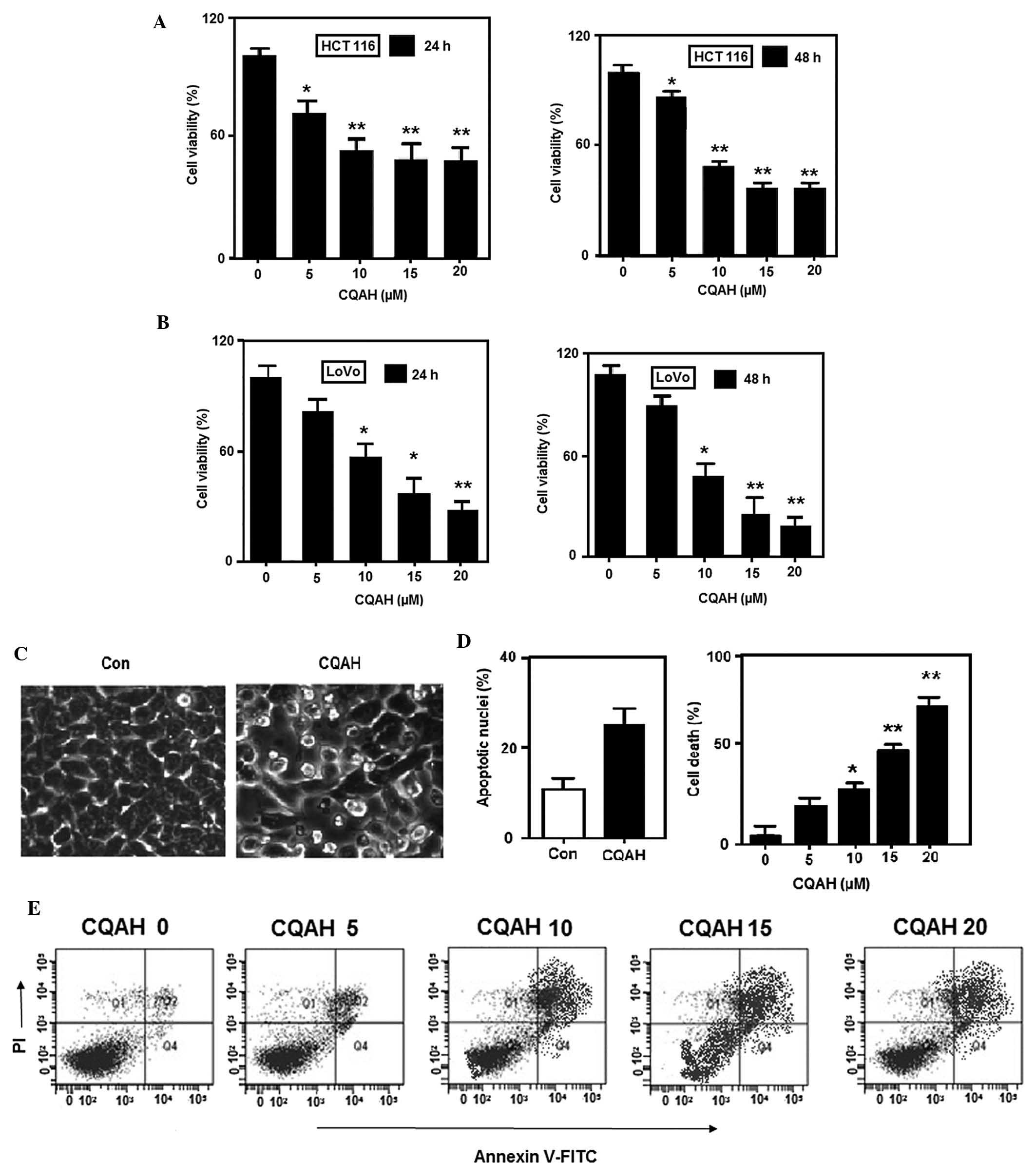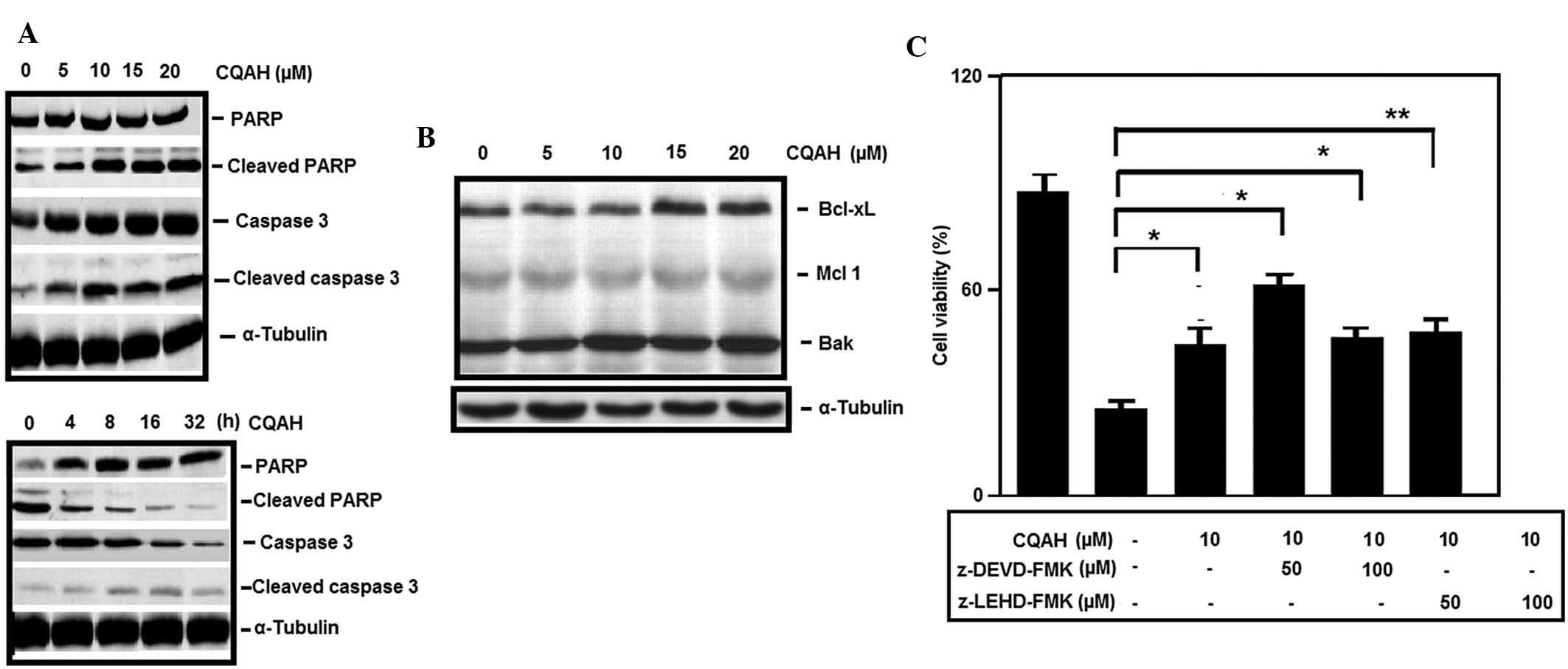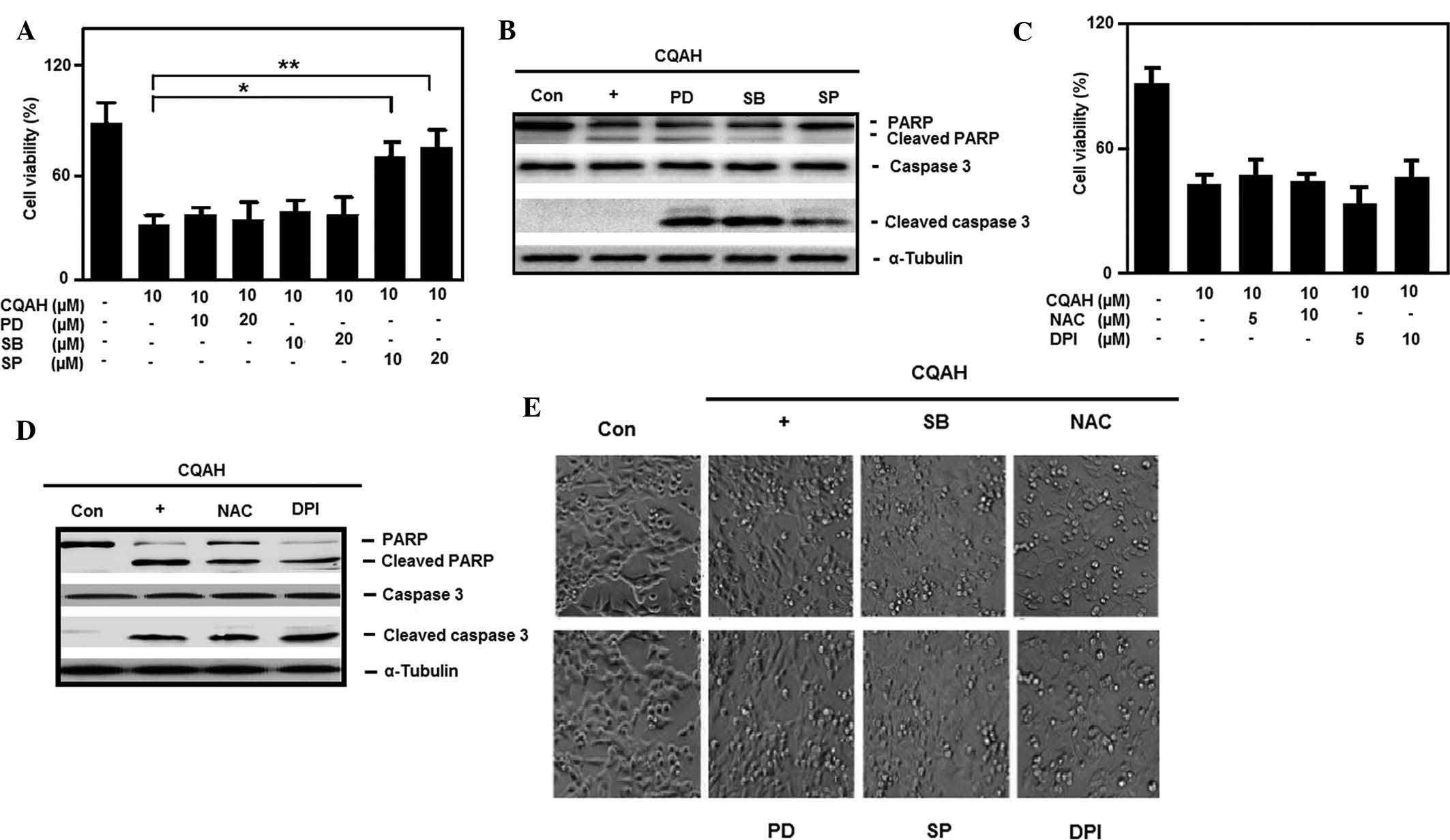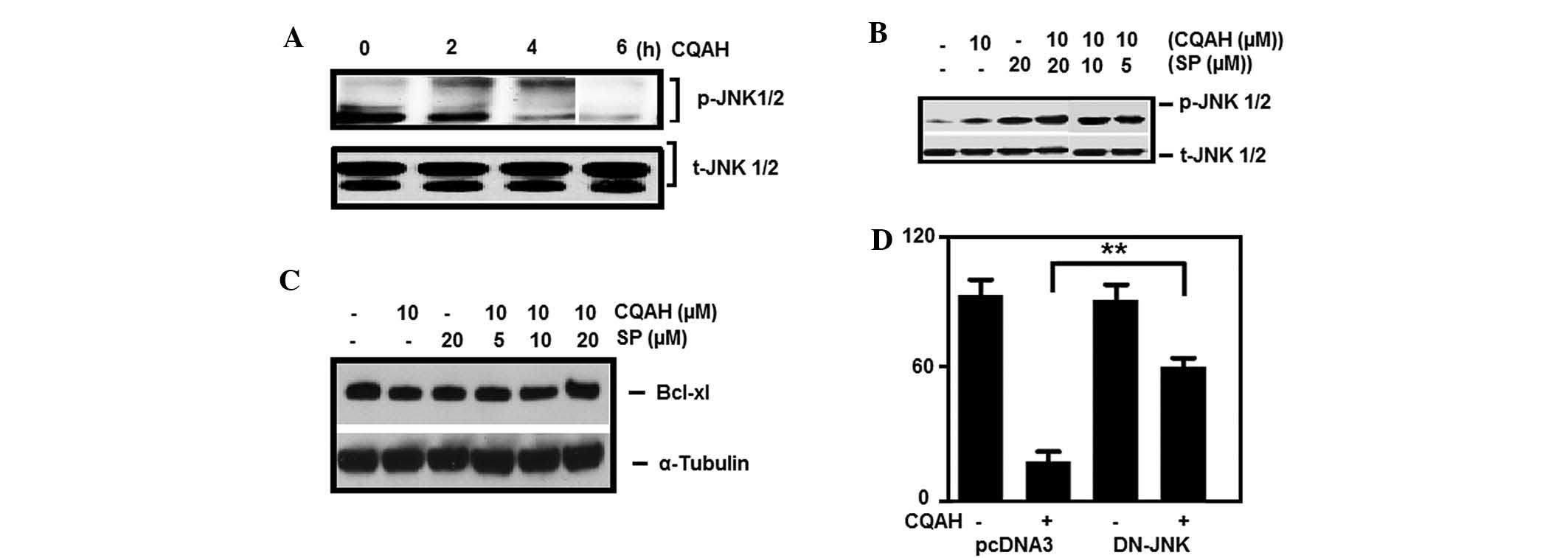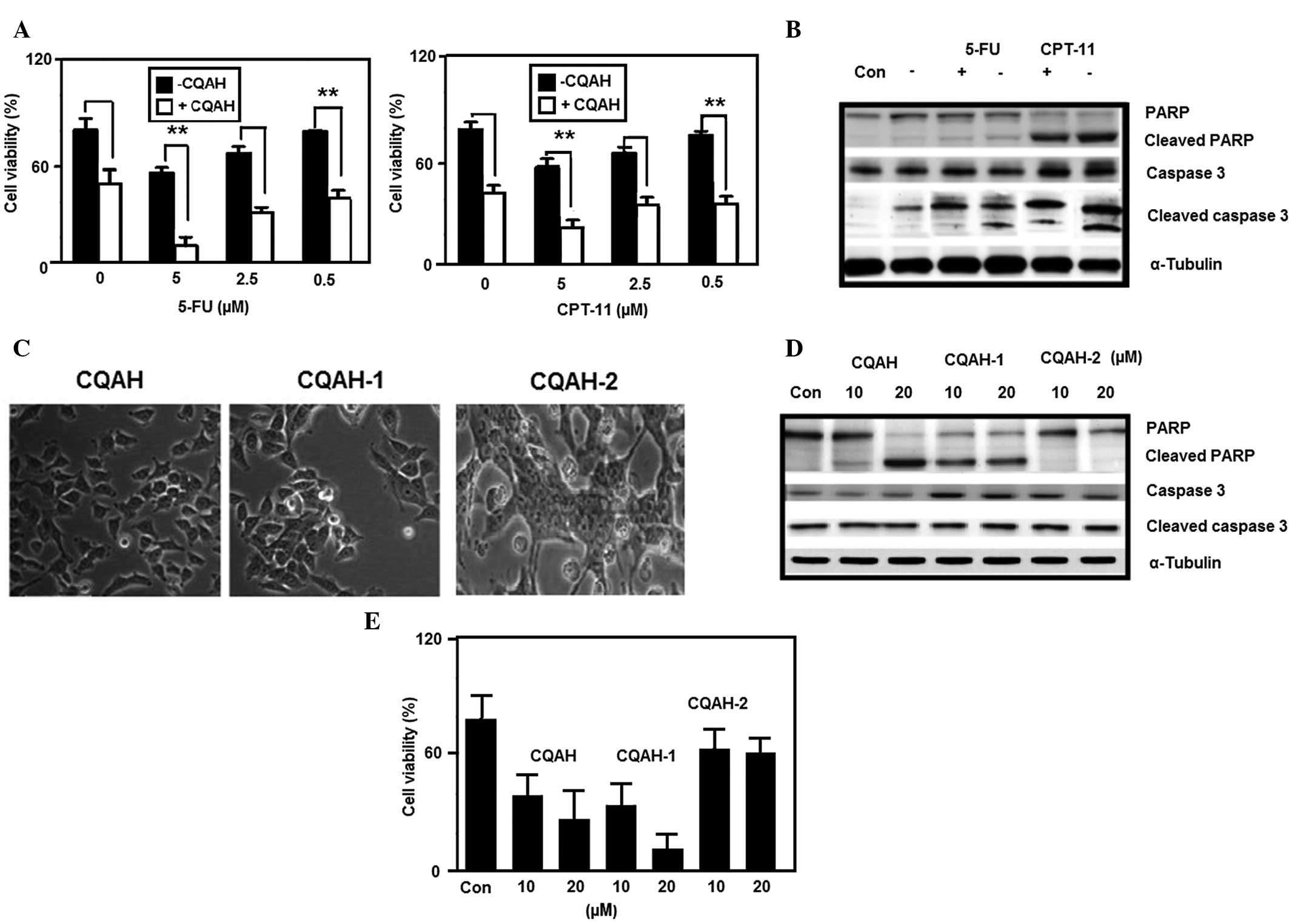|
1
|
Fearon ER and Vogelstein B: Genetic model
for colorectal cancer tumorigenesis. Cell. 61:759–767. 1990.
View Article : Google Scholar : PubMed/NCBI
|
|
2
|
Fearon ER and Jones PA: Progressing toward
a molecular description of colorectal cancer development. FASEB J.
6:2783–2790. 1992.PubMed/NCBI
|
|
3
|
Radtke F and Clevers H: Self-renewal and
cancer of the gut: two sides of a coin. Science. 307:1904–1909.
2005. View Article : Google Scholar : PubMed/NCBI
|
|
4
|
Nelson H, Petrilli N, Carllin A, Coutoure
J, Fleshman J, Guillem J, Miedema B, Ota D and Sargent D: National
Cancer Institute Expert Panel: Guidelines 2000 for colon and rectal
cancer surgery. J Natl Cancer Inst. 93:583–596. 2001. View Article : Google Scholar : PubMed/NCBI
|
|
5
|
O'Connell JB, Maggard MA and Ko CY: Colon
cancer survival rates with the new American joint committee on
cancer sixth edition tagging. J Natl Cancer Inst. 96:1420–1425.
2004. View Article : Google Scholar : PubMed/NCBI
|
|
6
|
Folprecht G, Grothey A, Alberts S, Raab HR
and Köhne CH: Neoadjuvant treatment of unresectable colorectal
liver metastases: Correlation between tumour response and resection
rates. Ann Oncol. 16:1311–1319. 2005. View Article : Google Scholar : PubMed/NCBI
|
|
7
|
Edwards MS, Chadda SD, Zhao Z, Barber BL
and Sykes DP: A systematic review of treatment guidelines for
metastatic colorectal cancer. Colorectal Dis. 14:e31–e47. 2012.
View Article : Google Scholar
|
|
8
|
Thun MJ, Namboodiri MM and Heath CW Jr:
Aspirin use and reduced risk of fatal colon cancer. N Engl J Med.
325:1593–1596. 1991. View Article : Google Scholar : PubMed/NCBI
|
|
9
|
Thun MJ, Namboodiri MM, Calle EE, Flanders
WD and Heath CW Jr: Aspirin use and risk of fatal cancer. Cancer
Res. 53:1322–1327. 1993.PubMed/NCBI
|
|
10
|
Marnett LJ: Aspirin and the potential role
of prostaglandins in colon cancer. Cancer Res. 52:5575–5589.
1992.PubMed/NCBI
|
|
11
|
Marnett LJ: Aspirin and related
nonsteroidal anti-inflammatory drugs as chemopreventive agents
against colon cancer. Prev Med. 24:103–106. 1995. View Article : Google Scholar : PubMed/NCBI
|
|
12
|
Giovannucci E, Rimm EB, Stampfer MJ,
Colditz GA, Ascherio A and Willett WC: Aspirin use and the risk for
colorectal cancer and adenoma in male health professionals. Ann
Intern Med. 121:241–246. 1994. View Article : Google Scholar : PubMed/NCBI
|
|
13
|
Giovannucci E, Egan KM, Hunter DJ,
Stampfer MJ, Colditz GA, Willett WC and Speizer FE: Aspirin and the
risk of colorectal cancer in women. N Engl J Med. 333:609–614.
1995. View Article : Google Scholar : PubMed/NCBI
|
|
14
|
Waddell WR and Loughry RW: Sulindac for
polyposis of the colon. J Surg Oncol. 24:83–87. 1983. View Article : Google Scholar : PubMed/NCBI
|
|
15
|
Waddell WR, Ganser GF, Cerise EJ and
Loughry RW: Sulindac for polyposis of the colon. Am J Surg.
157:175–179. 1989. View Article : Google Scholar : PubMed/NCBI
|
|
16
|
Giardiello FM, Hamilton SR, Krush AJ,
Piantadosi S, Hylind M, Celano P, Booker SV, Robinson CR and
Offerhaus GJ: Treatment of colonic and rectal adenomas with
sulindac in familial adenomatous polyposis. N Engl J Med.
328:1313–1316. 1993. View Article : Google Scholar : PubMed/NCBI
|
|
17
|
Giardiello FM, Offerhaus GJ and DuBois RN:
The role of nonsteroidal anti-inflammatory drugs in colorectal
cancer prevention. Eur J Cancer. 31A:1071–1076. 1995. View Article : Google Scholar : PubMed/NCBI
|
|
18
|
Hare JI, Neijzen RW, Anantha M, Dos Santos
N, Harasym N, Webb MS, Allen TM, Bally MB and Waterhouse DN:
Treatment of colorectal cancer using a combination of liposomal
irinotecan (Irinophore C™) and 5-fluorouracil. PLoS One.
8:e623492013. View Article : Google Scholar
|
|
19
|
Allen WL, Coyle VM, Jithesh PV, Proutski
I, Stevenson L, Fenning C, Longley DB, Wilson RH, Gordon M, Lenz HJ
and Johnston PG: Clinical determinants of response to
irinotecan-based therapy derived from cell line models. Clin Cancer
Res. 14:6647–6655. 2008. View Article : Google Scholar : PubMed/NCBI
|
|
20
|
Troiani T, Serkova NJ, Gustafson DL,
Henthorn TK, Lockerbie O, Merz A, Long M, Morrow M, Ciardiello F
and Eckhardt SG: Investigation of two dosing schedules of
vandetanib, ZD6474, an inhibitor of vascular endothelial growth
factor receptor and epidermal growth factor receptor signaling, in
combination with irinotecan in a human colon cancer xenograft
model. Clin Cancer Res. 13:6450–6458. 2007. View Article : Google Scholar : PubMed/NCBI
|
|
21
|
Pancreach E, Guérin E, Nicolet C,
Lelong-Rebel I, Voegeli AC, Oudet P, Larsen AK, Gaub MP and Guenot
D: Marked activity of irnotecan and rapamycin combination toward
colon cancer cells in vivo and in vitro is mediated through
cooperative modulation of the mammalian target of rapamycin/hypoxia
inducible factor-1apha axis. Clin Cancer Res. 15:1297–1307. 2009.
View Article : Google Scholar
|
|
22
|
Chen YL, Lin PC, Chen SP, Lin CC, Tsai NM,
Cheng YL, Chang WL, Lin SZ and Harn HJ: Activation of nonsteroidal
anti-inflammatory drug-activated gene-1 via extracellular
signal-regulated kinase 1/2 mitogen-activated protein kinase
revealed a isochaihulactone-triggered apoptotic pathway in human
lung cancer A549 cells. J Pharmacol Exp Ther. 323:746–756. 2007.
View Article : Google Scholar : PubMed/NCBI
|
|
23
|
Egan TJ: Interactions of quinoline
antimalarials with hematin in solution. J Inorg Biochem.
100:916–926. 2006. View Article : Google Scholar
|
|
24
|
Abonia R, Insuasty D, Castillo J, Insuasty
B, Quiroga J, Nogueras M and Cobo J: Synthesis of novel
quinoline-2-one based chalcones of potential anti-tumor activity.
Eur J Med Chem. 57:29–40. 2012. View Article : Google Scholar : PubMed/NCBI
|
|
25
|
Dürckheimer W, Blumbach J, Lattrell R and
Scheunemann KH: Recent developments in the field of β-Lactam
antibiotics. Angew Chem Int Ed Engl. 24:180–202. 1985. View Article : Google Scholar
|
|
26
|
Khalafallah AK, Selim MA, El-Hamd RMA,
Elmaghraby MA, Soleiman, et al: Novel synthesis of some new
fused/spiro heterocyclic compounds and their biological activity.
Indian J Chem. 34:1066–1070. 1995.
|
|
27
|
Parikh KA, Oza PS and Parikh AR: Synthesis
of some new 2-azetidinones as potential antitubercular agents.
Indian J Chem. 39B:7162000.
|
|
28
|
Patel NB and Patel JC: Synthesis and
antimicrobial activity of Schiff bases and 2-azetidinones derived
from quinazolin-4(3H)-one. Arabian J Chem. 4:403–411. 2011.
View Article : Google Scholar
|
|
29
|
Parmar SJ and Patel JI: Synthesis and
biological evaluation of some novel optically
active3-chloro-1-[4-({4-[(S)-(4-chlorophenyl)
(phenyl)methyl]-1-piperazinyl}acetyl)phenyl]-4-aryl-2-azetidin-onederivatives.
Der Pharma Chemica. 2:141–151. 2010.
|
|
30
|
Mathew B, Elizebeth MG, Mathew N and
Vijayabaskaran M: Synthesis, Characterisation of some 2-azetidinone
derivatives from 2-aminopyridine and evaluation of their
antimicrobial activity. Der Pharma Chemica. 6:238–242. 2012.
|
|
31
|
Vashi BS, Mehta DS and Shah VH: Synthesis
and biological activity of 4-thiazolidinones, 2-azetidinones,
4-imidazolinone derivatives having thymol moiety. Indian J Chem.
34B:802–808. 1995.
|
|
32
|
Polanski J, Niedbala H, Musiol R, Podeszwa
B, Tabak D, et al: 5-Hydroxy-8-nitro-6-quinaldic acid as a novel
molecular scaffold for HIV-1 integrase inhibitors. Lett Drugs Des
Disc. 3:175–178. 2006. View Article : Google Scholar
|
|
33
|
Polanski J, Niedbala H, Musiol R, Podeszwa
B, Tabak D, et al: Fragment based approach for the investigation of
HIV-1 integrase inhibition. Lett Drugs Des Disc. 4:99–105. 2007.
View Article : Google Scholar
|
|
34
|
Musiol R, Tabak D, Niedbala H, Podeszwa B,
Jampilek J, Kralova K, Dohnal J, Finster J, Mencel A and Polanski
J: Investigating biological activity spectrum for novel
quinolineanalogues 2: Hydroxyquinolinecarboxamides with
photosynthesis inhibiting activity. J Bioorg Med Chem.
16:4490–4499. 2008. View Article : Google Scholar
|
|
35
|
Jampilek J, Musiol R, Pesko M, Kralova K,
Vejsova M, Carroll J, Coffey A, Finster J, Tabak D, Niedbala H, et
al: Ring-substituted 4-Hydroxy-1H-quinolin-2-ones: Preparation and
biological activity. J Molecules. 14:1145–1159. 2009. View Article : Google Scholar
|
|
36
|
Patel R, Kumari P and Chikhalia K: Novel
s-Triazinyl piper-azines: Design, synthesis, characterization and
anti-microbial activity. Archives of Applied Science Research.
6:232–240. 2010.
|
|
37
|
Mistry B and Jauhari S: Synthesis and
characterization of some quinoline based azetidinones and
thiazolidinones as antimicrobial agents. Archives of Applied
Science Research. 6:332–343. 2010.
|
|
38
|
Parmar SJ and Patel IJ: Synthesis and
biological evaluation of some novel optically
active3-chloro-1-[4-({4-[(S)-(4-chlorophenyl)
(phenyl)methyl]-1-piperazinyl}acetyl)phenyl]-4-aryl-2-azetidin-onederivatives.
Der Pharma Chemica. 1:141–151. 2010.
|
|
39
|
Madhu G, Jayaveera KN, Ravindra Nath LK,
Kumar BS and Nagarjuna Reddy P: Synthesis and structure activity
relationship of new antibacterial active multi substituted
quinoline-azetidone mannich bases. Der Pharma Chemica. 3:1033–1040.
2012.
|
|
40
|
Johnson GL and Lapadat R:
Mitogen-activated protein kinase pathways mediated by ERK, JNK, and
p38 protein kinases. Science. 298:1911–1912. 2002. View Article : Google Scholar : PubMed/NCBI
|
|
41
|
Ishihara Y, Matsunaga K, Iijima H,
Hasegawa G, Suzuki T, Sato A, Kobayashi T, Yang M and Hoffman RM:
The combination of 5-FU, leucovorin and CPT-11 (FOLFIRI) prolongs
survival through inhibition of metastasis in an orthotopic model of
colon cancer. Anticancer Res. 30:403–408. 2010.PubMed/NCBI
|
|
42
|
Zhang W and Liu HT: MAPK signal pathways
in the regulation of cell proliferation in mammalian cells. Cell
Res. 12:9–18. 2002. View Article : Google Scholar : PubMed/NCBI
|
|
43
|
Olsson H, Sjö P, Ersoy O, Kristoffersson
A, Larsson J and Nordén B: 4-Anilino-6-phenyl-quinoline inhibitors
of mitogen activated protein kinase-activated protein kinase 2
(MK2). Bioorg Med Chem Lett. 20:4738–4740. 2010. View Article : Google Scholar : PubMed/NCBI
|
|
44
|
Wang X, Mader MM, Toth JE, Yu X, Jin N,
Campbell RM, Smallwood JK, Christe ME, Chatterjee A, Goodson T Jr,
et al: Complete inhibition of anisomycin and UV radiation but not
cytokine induced JNK and p38 activation by an aryl-substituted
hydropyrrolopyrazole quinoline and mixed lineage kinase 7 small
interfering RNA. J Biol Chem. 280:19298–19305. 2005. View Article : Google Scholar : PubMed/NCBI
|
|
45
|
Zhu BK, Wang P, Zhang XD, Jiang CC, Chen
LH, Avery-Kiejda KA, Watts R and Hersey P: Activation of Jun
N-terminal kinase is a mediator of vincristine-induced apoptosis of
melanoma cells. Anticancer Drugs. 19:189–200. 2008. View Article : Google Scholar : PubMed/NCBI
|
|
46
|
Muscarella DE and Bloom SE: The
contribution of c-Jun N-terminal kinase activation and subsequent
Bcl-2 phosphorylation to apoptosis induction in human B-cells is
dependent on the mode of action of specific stresses. Toxicol Appl
Pharmacol. 228:93–104. 2008. View Article : Google Scholar : PubMed/NCBI
|
|
47
|
Kelkel M, Cerella C, Mack F, Schneider T,
Jacob C, Schumacher M and Diederich M and Diederich M:
ROS-independent JNK activation and multisite phosphorylation of
Bcl-2 link diallyl tetra-sulfide-induced mitotic arrest to
apoptosis. Carcinogenesis. 33:2162–2171. 2012. View Article : Google Scholar : PubMed/NCBI
|
|
48
|
Leung KT, Li KK, Sun SS, Chan PK, Ooi VE
and Chiu LC: Activation of JNK pathway promotes phosphorylation and
degradation of BimEL-a novel mechanism of chemoresistance in T-cell
acute lymphoblastic leukemia. Carcinogenesis. 29:544–551. 2008.
View Article : Google Scholar : PubMed/NCBI
|
|
49
|
Donovan N, Becker EB, Konishi Y and Bonni
A: JNK phosphorylation and activation of BAD couples the
stress-activated signaling pathway to the cell death machinery. J
Biol Chem. 277:40944–40949. 2002. View Article : Google Scholar : PubMed/NCBI
|
|
50
|
Han MH, Kim GY, Yoo YH and Choi YH:
Sanguinarine induces apoptosis in human colorectal cancer HCT-116
cells through ROS-mediated Egr-1 activation and mitochondrial
dysfunction. Toxicol Lett. 220:157–166. 2013. View Article : Google Scholar : PubMed/NCBI
|
|
51
|
Zhao WX, Tang SS, Jin X, et al:
Olaquindox-induced apoptosis is suppressed through p38 MAPK and
ROS-mediated JNK pathways in HepG2 cells. Cell Biol Toxicol.
29:229–238. 2013. View Article : Google Scholar : PubMed/NCBI
|
|
52
|
Kuo YF, Su YZ, Tseng YH, Wang SY, Wang HM
and Chueh PJ: Flavokawain B, a novel chalcone from Alpinia pricei
Hayata with potent apoptotic activity: Involvement of ROS and
GADD153 upstream of mitochondria-dependent apoptosis in HCT116
cells. Free Radic Biol Med. 49:214–226. 2010. View Article : Google Scholar : PubMed/NCBI
|
|
53
|
Quan Z, Gu J, Dong P, Lu J, Wu X, Wu W,
Fei X, Li S, Wang Y, Wang J and Liu Y: Reactive oxygen
species-mediated endoplasmic reticulum stress and mitochondrial
dysfunction contribute to cirsimaritin-induced apoptosis in human
gallbladder carcinoma GBC-SD cells. Cancer Lett. 295:252–259. 2010.
View Article : Google Scholar : PubMed/NCBI
|



